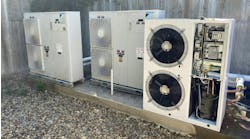What is continuous circulation control logic? This question has come up a lot lately. It addresses another one of those areas that is not well understood by American hydronics contractors. It isn’t understood because of the American way of doing things with bang-bang control logic (bang, it’s on, bang, it’s off).
Let’s face it, it’s not a good idea to keep a pump running if you have no zone valves open ... got the picture?
Let me refine my definition and what I just said will make more sense to you later on in the article.
Continuous circulation control logic in a forced-circulation system without outdoor reset was a popular option on this side of the pond about 50 years ago.
Let’s face it, gravity circulation is the ultimate continuous circulation system with outdoor reset. Even though the boiler didn’t have any fancy controls, if the system thermostat was set up correctly, the system did its own version of outdoor reset with variable-speed circulation.
When it’s cold outside, the room thermostat stays on longer, which causes the water to get hotter, which causes faster gravity circulation. When the weather is milder, the thermostat doesn’t call for heat as long, the boiler doesn’t get as hot and the circulation is slowed substantially.
If you’ve ever been inside of one of these older homes that has a gravity circulation system on a cold winter day, you’ve experienced the comfort associated with this practice. Warm, warm, warm. Uncomfortably warm in some cases but, nonetheless, warm.
During the ’40s and ’50s when one-pipe hydronic heating systems were common, continuous circulation was also popular. The piping system made this possible.
Due to the “bypass” nature of one-pipe systems, a person could close off convectors in unused areas of a given circuit without affecting the output of the other convectors on the same loop, and without the possibility of “dead heading” the system circulator. Hence, continuous circulation. Outdoor reset controls were added later, and the systems became closer to what we today know as a continuous circulation type of system.
The key to continuous circulation is having a hydronic distribution system and control logic that is conducive to this type of operation. The typical American system with zone valves on every circuit is not conducive to this type of design logic.
In order for this logic to work correctly, there must be at least one wide-open loop, which is generally referred to as the “reference loop.” The area being served by this loop is the room that the indoor/outdoor reset controller “looks” at to see how the system is doing. This loop should have some means of restricting flow through it so that when other more controlled loops come online, they will not be starved for flow.
Moreover, if the water flows through the reference loop too quickly, hydrolysis, or erosion corrosion, could be a problem.
I like to use a pressure-assisted bypass valve for this function of the logic, and I will spend my next article explaining its operation.
For the sake of simplicity, an adjustable balance cock will roughly serve the same purpose as the pressure-assisted bypass. It’s just not as intelligent.
When using this type of control logic, not all loops are wild and uncontrolled. Only the reference loop is wild. All other loops can be controlled conventionally, using two-way zone valves (electric or non-electric), and in some cases, three-way bypass valves (electric and non-electric). What are the advantages of using this logic?
It reduces expansion and contraction noises in the distribution system associated with bang-bang control logic. This is especially handy when dealing with some of these noisy staple-up radiant floor-heating systems.
It allows the mean radiant temperature to be more effective. The higher the mrt, the lower the air temperature can be and the occupants will still be comfortable.
It keeps the home more evenly heated because the distribution becomes a part of the radiation. It reduces wear and tear on the system circulator. When properly controlled, it can save energy and make the system more efficient.
A word of caution here. The boiler must be conducive to this design in order for it to work correctly without causing the early demise of your boiler. If you’re going to do a large water temperature reset, say 70°F to 180°F, make sure the appliance from which you are getting the heat is compatible with this logic. That means condensing boiler technology.
If it’s not compatible, you’ll have to rework some of the boiler room piping to protect your boiler from long-term condensation problems. If you take this into consideration in the initial design stages, it’s no big deal. In some retrofit situations, it can turn into a major boiler room re-piping ordeal. The answer is the use of primary/secondary piping with a variable-speed injection loop between the two of them.
By now, I hope you can see why the typical American system with all zone valves is not conducive to this type of operation and you understand my statement about circulators running with no zone valves open. Thinking outside the box can be fun!
I’ve included a simple schematic showing how a continuous circulation system would look.

